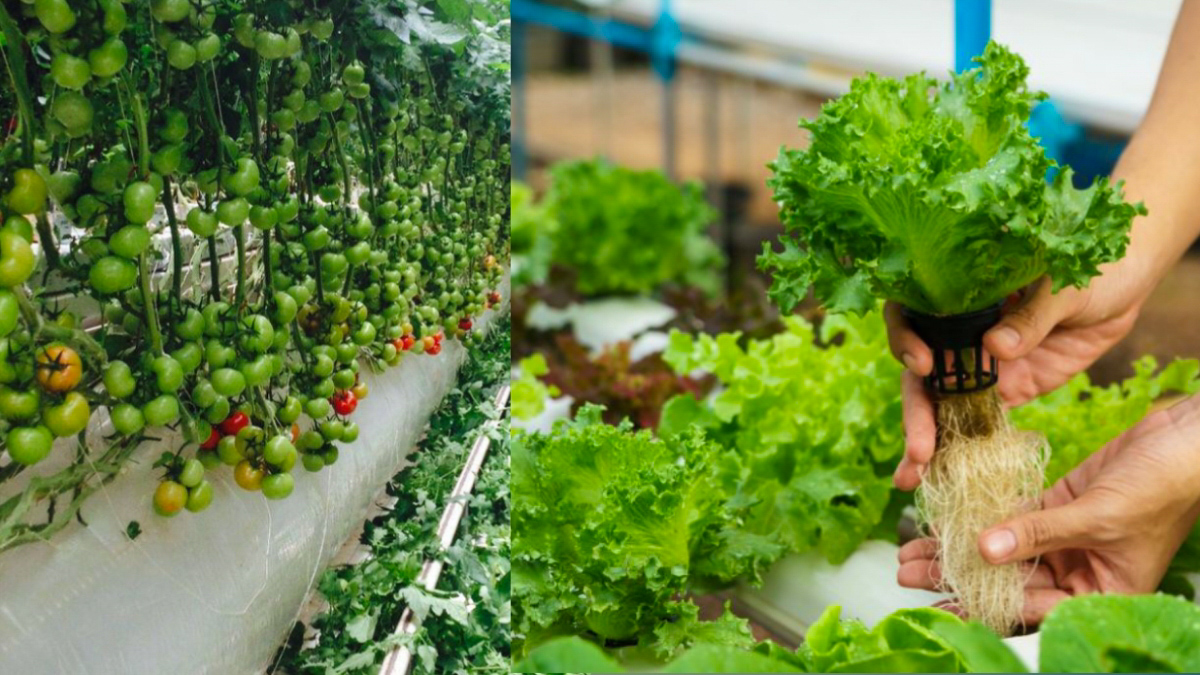Are you dreaming of growing fresh vegetables at home but limited by space, poor soil, or seasonal constraints? Say hello to hydroponic systems for indoor vegetable gardens—a revolutionary way to grow plants without soil and right from the comfort of your apartment or home!
In this ultimate guide, you’ll discover everything you need to know about setting up a successful hydroponic vegetable garden indoors—from choosing the right system and crops to expert maintenance tips. Whether you’re a gardening newbie or an urban farming enthusiast, this article is your roadmap to year-round, pesticide-free produce.
🌱 What is Hydroponics?
Hydroponics is a method of growing plants in a nutrient-rich water solution instead of traditional soil. With the right balance of light, water, and nutrients, hydroponically grown vegetables can thrive faster and healthier than their soil-grown counterparts.
This method is especially ideal for urban dwellers with limited outdoor space. From countertops to spare shelves, you can transform almost any area into a lush indoor garden.
🌟 Benefits of Using Hydroponic Systems Indoors
Why should you consider hydroponic gardening at home? Here are some compelling benefits:
- Space-efficient – Perfect for apartments, condos, or small homes.
- Faster growth rate – Plants grow up to 50% faster than in soil.
- Year-round gardening – No worries about seasons or weather changes.
- Water-saving – Uses up to 90% less water than traditional gardening.
- Cleaner and easier – No messy soil, fewer pests, and minimal maintenance.
💡 Best Hydroponic Systems for Indoor Vegetable Gardening
Here’s a breakdown of the top indoor hydroponic systems you can use, whether you’re a beginner or a seasoned grower:
1. Deep Water Culture (DWC)
Plants sit in a net pot and their roots are submerged in an oxygenated nutrient solution.
- 🟢 Best For: Lettuce, spinach, herbs
- ✅ Pros: Easy to set up, low maintenance
- ❌ Cons: Requires good air circulation and water temperature control
2. Nutrient Film Technique (NFT)
A shallow stream of nutrient solution continuously flows over the plant roots.
- 🟢 Best For: Leafy greens
- ✅ Pros: Efficient water use, continuous nutrient delivery
- ❌ Cons: Not suitable for large plants
3. Wick System
Uses capillary action to draw nutrient solution up to the plant roots.
- 🟢 Best For: Small herbs and microgreens
- ✅ Pros: Passive system, no electricity needed
- ❌ Cons: Slower growth, not suitable for larger plants
4. Ebb and Flow (Flood and Drain)
The grow tray is periodically flooded with nutrient solution and then drained.
- 🟢 Best For: Tomatoes, peppers, strawberries
- ✅ Pros: Versatile, supports various plant sizes
- ❌ Cons: More complex setup, needs timer control
5. Aeroponics
Roots are suspended in air and misted with nutrient solution.
- 🟢 Best For: High-tech gardeners
- ✅ Pros: Maximum oxygen exposure, fast growth
- ❌ Cons: Expensive and needs constant monitoring
🍅 Best Vegetables to Grow in Indoor Hydroponic Systems
Not all veggies love hydroponics equally. Here are some top performers you can grow with success:
| Vegetable | Recommended System | Growth Time | Notes |
|---|---|---|---|
| Lettuce | DWC, NFT | 30–45 days | Fast and beginner-friendly |
| Basil | Wick, DWC | 30 days | Loves warmth and LED lights |
| Spinach | NFT, DWC | 40 days | Cool weather variety |
| Kale | DWC, NFT | 55 days | Needs good root space |
| Tomatoes | Ebb & Flow, DWC | 60–80 days | Needs support and pruning |
| Peppers | Ebb & Flow | 60–90 days | Requires more light and space |
| Strawberries | Ebb & Flow, NFT | 60 days | Great for vertical systems |
🛠️ How to Set Up a Hydroponic Garden at Home
Starting your indoor hydroponic journey can be both exciting and manageable. Here’s a step-by-step guide to setting up your first system:
1. Choose the Right System
Pick one based on your space, experience, and vegetable goals.
2. Select Your Location
Find a bright area with access to a power outlet. A south-facing window or a shelf with grow lights is ideal.
3. Gather Supplies
You’ll need:
- Reservoir (for nutrient solution)
- Grow tray or net pots
- Air pump or water pump (depending on system)
- Nutrient solution
- pH meter/test kit
- LED grow lights (if sunlight is limited)
4. Add Plants or Seeds
Start with seedlings or use rockwool cubes for germinating seeds. Place them in the net pots securely.
5. Monitor & Maintain
- Maintain pH between 5.5–6.5
- Replace nutrient solution every 1–2 weeks
- Check water levels, temperature, and lights daily
🔄 Maintenance Tips for a Thriving Hydroponic Garden
- Clean regularly: Flush the system with clean water monthly.
- Watch for algae: Keep light away from the nutrient solution to prevent growth.
- Inspect roots: Healthy roots should be white or light tan.
- Rotate crops: Avoid nutrient depletion by switching plants after harvest.
🚫 Common Mistakes to Avoid
- Ignoring water pH – It’s crucial to maintain optimal pH for nutrient uptake.
- Overcrowding plants – Leads to poor air circulation and stunted growth.
- Insufficient lighting – Vegetables need at least 12–16 hours of light daily.
- Skipping system checks – A single failure (like a pump outage) can ruin your crop.
❓ Hydroponic Gardening FAQ
Q: Is hydroponic gardening expensive?
A: It can be as affordable or premium as you want. Basic wick systems start under $50, while advanced aeroponics setups can run into hundreds.
Q: Can I use regular plant fertilizer?
A: No. Use hydroponic-specific nutrient solutions designed for water-based systems.
Q: How much light do indoor hydroponic plants need?
A: Most veggies need 12–16 hours of full-spectrum grow lights per day.
Q: Can I grow root vegetables like carrots or potatoes?
A: These are not ideal due to their large space and root depth needs. Stick with leafy greens, herbs, tomatoes, and peppers.
🌿 Final Thoughts: Start Your Indoor Hydroponic Garden Today
Hydroponic gardening is a game-changer for anyone who wants to grow their own vegetables indoors, even in small spaces. It’s clean, efficient, eco-friendly, and incredibly rewarding.
Whether you want fresh basil for your pasta or vine-ripened cherry tomatoes all year round, there’s a hydroponic system out there for you. Start small, experiment, and enjoy the journey of growing your own food—right from your windowsill or kitchen counter.
✅ Ready to Start?
If you found this guide helpful, share it with fellow plant lovers or bookmark it for your next green project. Want a step-by-step hydroponic setup checklist? Let me know, and I’ll create one for you!

